Chapter 19 Bonsai Soil Mixes
19.1 My Bulk Growing Mixes
I grow a lot of trees from seed and liners, and I like to get them into soil mix that is similar to their final bonsai soil as early as I can. I have listed the relative ratios of grit, bark, and other components of each mix as if I were making a large batch for filling training pots or trays.
I do not screen the components of the bulk soil mix I use for training pots or general cultivation unless the batch of bark I am using has a lot of large chunks, or the grit mix has large stones. I simply layer the organic and inorganic materials on a large tarp, add lime or other amendments, turn everything by hand until mixed, then store the mix in 40-gallon garbage cans.
My bulk supplier sells fresh rather than aged, composted bark. To counteract nitrogen draw-down, I add 15 lbs/yd of Espoma Plant-Tone [5-3-3, plus starter inoculum of soil microbes]. Plant-Tone is an organic fertilizer that breaks down slowly, so it does not burn the roots of newly repotted trees.
I also add 5-10 lbs of dolomite limestone to each yard of bark to raise the pH. I know from making test batches that the bark I use has a base pH of 5.0 to 5.5. Five pounds of limestone per yard is not going to be enough in most batches, but is a good starting point. I add the first 5 pounds, mix, and do a pH dipstick check. If the pH is below 6.0, I add another 2-5 pounds per yard then check it again.
19.1.1 General Purpose Grit Mix
This is the all-purpose inorganic materials mix I use routinely. It is easy to prepare in bulk, has particles of different sizes, and has worked well for me in most soil mixes.
- 1 part sand (sharp masonry sand or filtration sand, but NOT play sand)
- 1 part granite paver base or granite screenings, sifted through 1/4-inch screen
- 1 part masonry gravel, Permatill, Turface, or similar sharp gravel
In some batches I have replaced these components with other materials such as the smallest size chicken grit instead of masonry sand. I keep coming back to this mix because I can get the components reliably without paying a small fortune.
19.1.2 Tub and Tray Seed Starting Mix
I use this mix in dishpans and concrete mixing tubs to sow collected tree seeds in fall. I leave the pans outdoors to stratify over the winter. I use the same mix to start seeds that I pre-stratified in moss in the refrigerator, Using deeper containers to start seeds means I can keep the seedlings in their starting containers for 6 months to a year until they are larger and better developed.
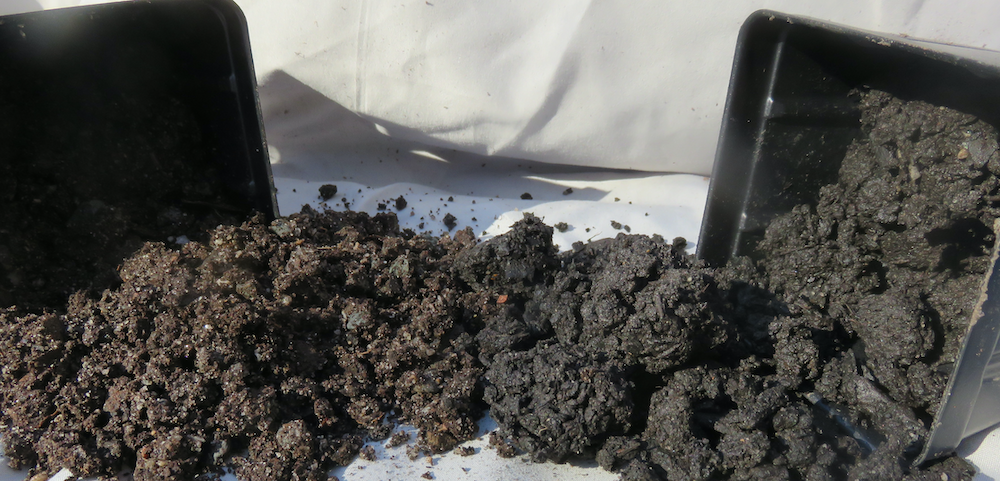
Amended topsoil. The container on the left shows the topsoil plus bark mix, the container on the right, the unamended soil. Adding more bark helps minimize clumping and produces finer feeder roots on seedlings. Original photo by Dan Johnson.
I do not add limestone because the soil in the mix stabilizes the pH enough; if in doubt, check the pH with a dip strip.
- 1 part bark
- 1 part Scott’s black topsoil (not their more expensive specialty blends)
- Dolomitic limestone to balance pH (optional)
19.1.3 Seedling to Mini-Pot Transition Mix
This is the mix I use when potting up woody seedlings from pans (previous mix) into individual 4-inch or Anderson band pots. It has more grit to encourage finer root branching and improve drainage. It also starts the process of transitioning seedlings to bonsai soil.
- 4 parts bark
- 1 part grit
- 2-3 parts black topsoil
- Dolomitic limestone to balance pH (if needed; start with 5 lbs/yd)
19.1.4 Rich Mix/Bog Mix
This is my standard mix now for growing tropicals, serissa, bougainvillea, and bamboo. Coconut coir increases its water holding capacity without it staying soggy.
- 4 parts bark
- 1 part coir
- 1 part grit
- Dolomitic limestone as needed to balance pH (~5 lbs/yd)
If I am planting something that needs VERY moist soil (swampland specialists), I switch the coir and 1 part of bark for 2 parts sphagnum peat moss. I only use the bog mix for things like carnivorous plants, swamp hibiscus, papyrus sedge, or similar plants that need to stay in standing water.
19.1.5 Moist Deciduous Mix/Go-To Mix
I use this mix for riparian and moist woodland species (red and Japanese maples, hornbeams). Many references say to grow maples in a grittier mix like the next mix below, but in practice I find this mix helps my Japanese maples tolerate our summer heat better. It still drains well.
- 4 parts bark
- 1 part grit
- Dolomitic limestone as needed to balance pH (~5 lbs/yd)
This is my “go-to mix” that I make in bulk every spring, and adjust as needed. If I have conifers to pot up, I just mix in more grit. If I need moisture retention, I add some coir or peat moss. If I have acid-loving trees, I mix it 1:1 with bark and do not add additional limestone.
19.1.6 General Deciduous Mix / Rich Conifers Mix
For oaks, trident maples, hackberry, larch, bald cypress
- 3 parts bark
- 1 part grit
- Dolomitic limestone as needed to balance pH (~5 lbs/yd)
19.1.7 Lean Conifers Mix
Best for pines, early colonizer species. I think limestone is optional here because pines and other colonizer species tend to be less fussy about pH.
- 2 parts bark
- 1 part grit
- Dolomitic limestone as needed to balance pH (~5 lbs/yd)
19.1.8 Ericaceous Mix
For azaleas and other acid-Loving species. Shoot for pH 5.5 to 6.0, but no higher.
- 3 parts composted pine bark
- 1 part peat
- 1-2 parts grit depending on drainage required
- Lime to balance pH (may not be required, 2 lbs/yd is upper limit)
19.2 Preparing Materials For Trees in Show Pots
Soil particle size becomes much more important when trees go into show pots. Soil that is too fine- grained will not drain well and can cause root rot, while large grains will dry out too quickly causing drought stress.
I find it is easiest to screen a couple five gallon buckets each of organic and inorganic materials, then mix them together later as I need them. Working over a wheelbarrow, I pour about 10 pounds of shredded pine bark onto a 2 x 3–foot piece of 1/4–inch mesh screen, and shake it until particles stop falling through. I use larger pieces remaining on the screen to amend soil around trees that I am growing in the ground to thicken their trunks, or add them to the compost heap. Next I screen the pine bark a second time using a piece of standard window screen. This time I keep the particles that stay on top of the window screen. The fine material that passes through the screen can be used to make a fine grained soil mix for growing mosses, or composted.
To every 5 gallons of sieved soil mix, I add 1/8-1/4 cup of dolomitic limestone (equivalent to 5 lb./yd.) then check the pH with dip strips. If the bark is not well aged, I also add 1/2 cup of Espoma Plant-Tone to counteract the nitrogen draw-down.
Next I screen inorganic matter. Wear a dust mask or bandana over your mouth and nose when you screen inorganic materials, as chronic exposure to rock dust can lead to lung diseases. Again I use the larger particles that do not pass through the large mesh to amend soil around trees that I am planting out. I store the material remaining on top of the window screen, and add the fine waste dust to the compost heap.
When you are ready to repot a tree into a show container, mix the correct proportions of organic and inorganic matter from your buckets of prepared materials. Stir the two dry components together thoroughly in a plastic pan. Moisten the mixture slightly, then repot as usual.
19.2.1 Which mixture for which species?
I compiled this table using Low Maintenance Bonsai by Herb Gustafson, and Bonsai Survival Manual by Colin Lewis as starting references. It gives preferred ratios of organic to inorganic matter for many species used in bonsai. If your specific tree is not listed, choose a more common species that shares the same habitat, then use the soil ratio recommended for that species.
| For These Species | Use a Mix of: |
|---|---|
| Bamboos, fukien tea, serissa | 80% organic,20% inorganic |
| Azalea, bald cypress, bouganvillea, crabapple, ficus, nandina, quince, redwood, rhododendron, spruce, most tropicals | 70% organic, 30% inorganic |
| Alder, beech, birch, crabapple, crape myrtles, elms, hackberry, Hinoki cypress, hornbeam, maple, pistachio, privet, quince, yew | 60% organic, 40% inorganic |
| Boxwood, cherry, cotoneaster, cryptomeria, gingko, holly, pyracantha, wisteria | 50% organic, 50% inorganic |
| Firs, most cypress, hemlock, junipers, larch, myrtle, spruce | 40% organic, 60% inorganic |
| Desert plants, eucalyptus, jades, oaks, olive, most pines | 30% organic, 70% inorganic |
19.3 NC Arboretum Bonsai Mix
Given the range of soil mixes available commercially, it seems like bonsai trees (and nursery stock in general) can adapt to a variety of soil mixes and still do well. I am not alone in thinking this. I once asked Arthur Joura, Director of the Bonsai Collection at the NC Arboretum in Asheville, what they use. This is how he responded.
“Before sharing my mix, I need to convey one important point: I do not recommend to anyone the bonsai potting medium I use here at the Arboretum. It is not that I doubt its validity - I use it because I think well of it. Rather, the subject of bonsai potting medium seems to be fraught with such vehemently held opinions that I have no interest in engaging in the subject. At the risk of being misunderstood as rude, I tell you with great earnestness it is no matter to me what anyone else chooses to use as a bonsai medium.
I am sharing Arthur’s mix recipes below so you can compare them to mine, then decide for yourself how much effort you want to put into creating different soil mixes. I have gently edited his original recipes to make measuring easier. One cubic yard is equal to 201 gallons. Use a 5-gallon bucket or 40-gallon plastic trash can as a measuring container.
Mix 1 yard of organic materials.
- 4 parts (0.8 yards, or 160 gallons) composted pine bark, unsifted
- My note: If using fresh bark, you may want to add 10 lb blood meal or Epsoma Plant-Tone to counter potential nitrogen draft.
- 1 part (0.2 yards, or 40 gallons) Canadian peat moss, unsifted
- 14 cups (~10 lb.) of pulverized dolomitic limestone
- 7 cups Scott’s Micro-Max nutrient powder
For an all-purpose bonsai mix, combine:
- 1 part of organic materials
- 1 part Stalite Permatill, pre-sifted to a particulate size of 1/8" to 1/4"
Alter the ratio of standard potting mix to Stalite Permatill depending on what species of plant is being potted. Arthur says most Arboretum bonsai are potted in the all-purpose mix. Any alterations to the standard mix he does by eye and by feel.
To make an ericaceous mix for acid-loving species adjust the organic mix to:
- 3 parts (0.75 yards, or 150 gallons) composted pine bark
- 1 part (0.25 yards, or 50 gallons) peat
- Reduce added limestone to 3 cups (2 lb)/yd.
19.4 Special Use Mixes
Muck Soil
This is not used for planting trees, but for building berms and binding roots to rocks. There are many versions but all follow the same basic principle: the mix should be moisture retentive, sticky, and have some sort of fibrous material to provide greater cohesive strength.
1. 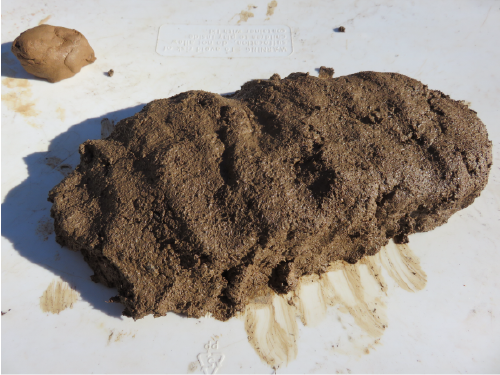 2.
2. 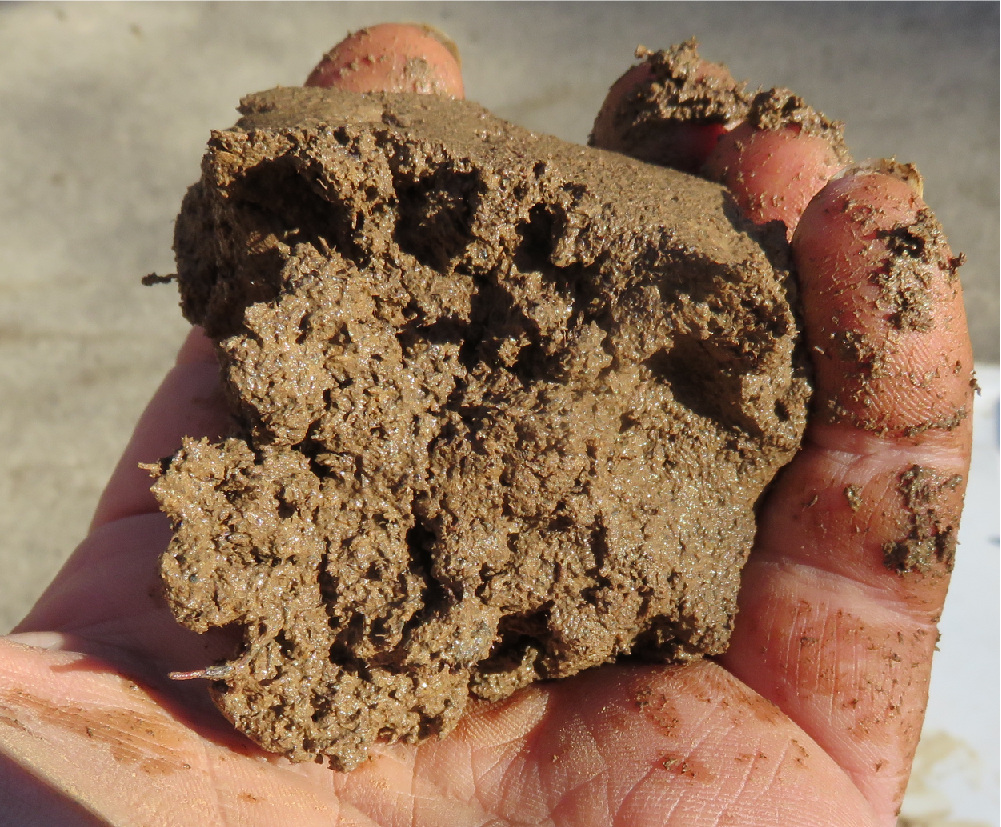
Image 1. A lump of 2-part muck, a 1:1 mix of clay and peat. Image 2. Close-up of 2-part muck. Without the cow manure this muck is very nutrient poor, but not quite as sticky when being handled, which makes it easier to use for demonstration purposes. Original photos by Dan Johnson.
I have provided several examples. For all versions, mix any dry ingredients first then knead together with wet materials until stiff but sticky, adding water as needed. Store in poly bags. None of the materials are toxic, but many people wear gloves to handle muck because it is hard to wash off your hands.
Don’t stress over the type of clay; I regularly find large clumps of serviceable clay while digging in my yard. Red, gray, or yellow subsoil clay, river clay, and even pottery clay all work well; just use less water.
1. 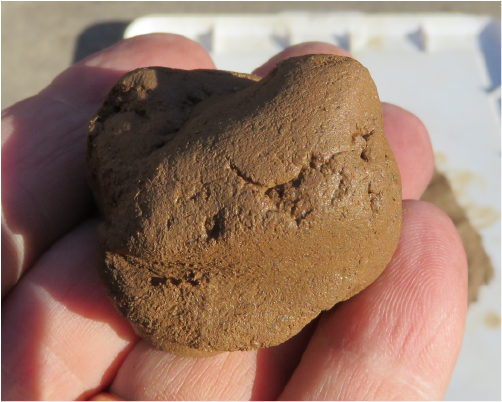 2.
2. 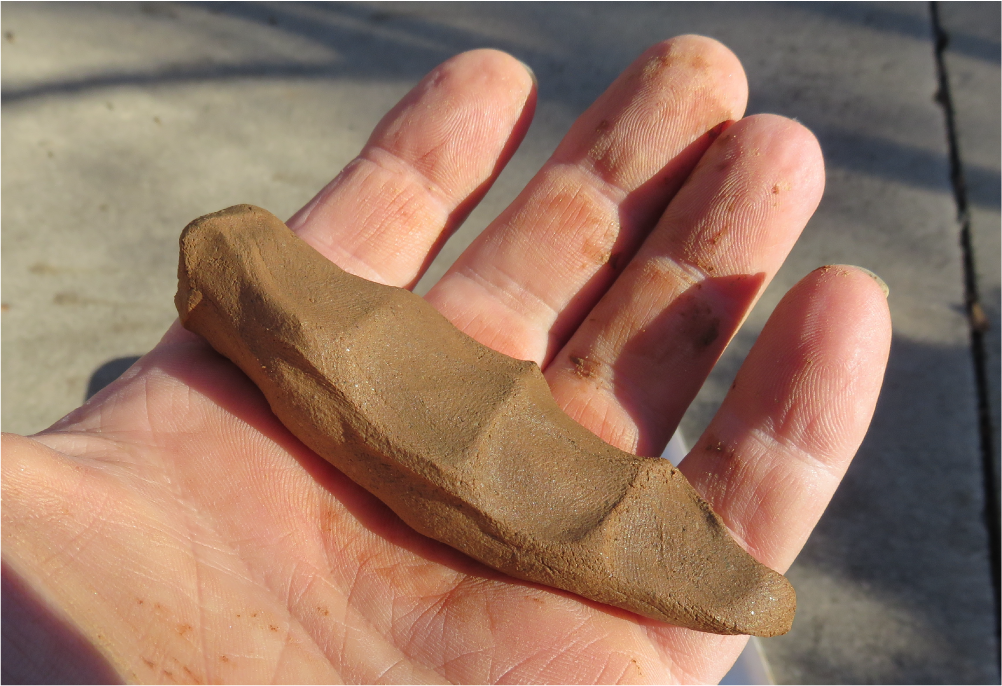
Image 1. A sample of our local subsoil clay. Image 2. Our particular clay is not suitable for fired pottery, but makes good bonsai muck soil. Original photos by Dan Johnson.
If you want to used powdered clay, bentonite can be purchased from Amazon in the beauty products (it is used for clay mask mixes).
Composted cow manure and bagged sphagnum moss (NOT peat moss) are available in most garden centers. Michigan reed sedge peat is hard to find locally and costs a lot to order online. If you get a large bag, you probably will not use it all. Consider sharing it with 3-4 people.
Muck Version 1
- 1 part subsoil or river clay
- 1 parts composted cow manure
- 1 part sphagnum moss milled or mashed to consistency of corn grits
Muck Version 2
- 1 part powdered bentonite clay
- 5 parts composted cow manure
- 1 part sphagnum moss chopped to less than 1-inch lengths
Muck Version 3
- 1 part clay
- 1 part long fiber sphagnum moss
- 1 part Michigan peat
Muck Version 4
- 6 parts Michigan peat
- 4 parts milled sphagnum moss
- A little akadama clay, crushed (provides adhesion)